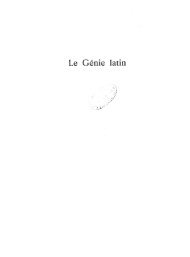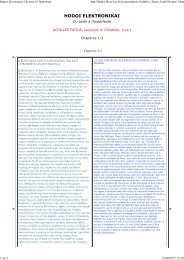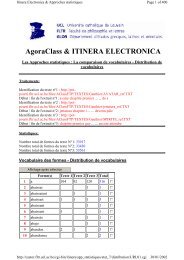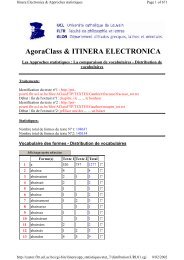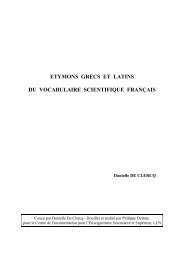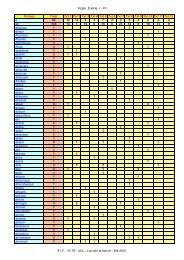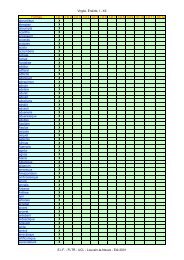The Etymologies of Isidore of Seville - Pot-pourri
The Etymologies of Isidore of Seville - Pot-pourri
The Etymologies of Isidore of Seville - Pot-pourri
You also want an ePaper? Increase the reach of your titles
YUMPU automatically turns print PDFs into web optimized ePapers that Google loves.
third has a half, thus: (fig.). <strong>The</strong> fourth is full, thus: (fig.).<br />
<strong>The</strong> fifth is half again, [from the full side], thus: (fig.).<br />
<strong>The</strong> sixth is a section again, thus (fig.). <strong>The</strong> seventh is<br />
two-horned, thus: (fig.). 2.<strong>The</strong>seventh lunar day, when<br />
the moon is a half, and the twenty-second, when it is a<br />
half, are the midpoints <strong>of</strong> its orbit (fig.), and the other<br />
days are proportional.<br />
lv. Interlunar intervals (De interluniis) <strong>The</strong> interlunar<br />
interval <strong>of</strong> the moon is the time between the waning<br />
and the waxing moon. This is the thirtieth day, when the<br />
moon does not shine. At that time the moon cannot be<br />
seen, because it is in conjunction with the sun and darkened.<br />
But it is seen the moment it isrebornbymoving<br />
gradually away from the sun.<br />
lvi. <strong>The</strong> path <strong>of</strong> the moon (De cursu lunae) 1. <strong>The</strong><br />
moon measures out the span <strong>of</strong> a month in its alternations<br />
<strong>of</strong> losing and receiving light. <strong>The</strong>refore, it proceeds<br />
on an oblique path, not a straight one like the sun,<br />
indeed, lest it fall into the central plane <strong>of</strong> the earth and<br />
frequently undergo eclipse. 2.For its circular path is close<br />
to the earth. When it is waxing, its horns look to the east,<br />
and when it is waning they look to the west, and justly<br />
so, since it is about to set and lose its light.<br />
lvii. <strong>The</strong> proximity <strong>of</strong> the moon to the earth (De vicinitate<br />
lunae ad terras) <strong>The</strong> moon is nearer to the earth<br />
than the sun is. Whence, due to its shorter orbit, it completes<br />
its course more quickly, for the journey that the<br />
sun completes in 365 days the moon runs through in<br />
thirty days. Whence the ancients established months<br />
based on the moon, and years based on the course <strong>of</strong><br />
the sun.<br />
lviii. Eclipse <strong>of</strong> the sun (De eclipsi solis) An eclipse<br />
<strong>of</strong> the sun occurs whenever the moon, on the thirtieth<br />
lunar day, comes to that line where the sun travels, and<br />
by interposing itself before the sun, conceals it. Thus to<br />
us the sun appears to vanish when the orb <strong>of</strong> the moon<br />
is set before it.<br />
lix. Eclipse <strong>of</strong> the moon (De eclipsi lunae) 1.Aneclipse<br />
<strong>of</strong> the moon occurs whenever the moon runs into the<br />
32 <strong>Isidore</strong> himself is among those who do not observe these differentiae.<br />
<strong>The</strong> <strong>Etymologies</strong> III.liv.2–lxv 103<br />
shadow <strong>of</strong> the earth. <strong>The</strong> moon is thought not to have<br />
its own light, but to be illuminated by the sun; hence it<br />
disappears if the earth’s shadow comes between it and<br />
the sun. 2. Thishappens to the moon on the fifteenth<br />
lunar day, until it leaves the central part and the shadow<br />
<strong>of</strong> the intervening earth and sees the sun, or is seen by<br />
the sun.<br />
lx. <strong>The</strong> differences between stars, star clusters, and<br />
constellations (De differentia stellarum, siderum, et<br />
astrorum) 1. Stars (stella), star clusters (sidus), and constellations<br />
(astrum)aredifferentfromeachother.Thusa<br />
star is any individual body, but star clusters are made up<br />
<strong>of</strong> several stars, such as the Hyades and the Pleiades. 2.<br />
Constellations are large patterns <strong>of</strong> stars, such as Orion<br />
and Bootes. But writers confuse these terms, and use<br />
astrum instead <strong>of</strong> stella,andstella instead <strong>of</strong> sidus. 32<br />
lxi. <strong>The</strong> light <strong>of</strong> stars (De lumine stellarum) Stars are<br />
said not to possess their own light, but to be illuminated<br />
by the sun, as the moon is.<br />
lxii. <strong>The</strong> location <strong>of</strong> the stars (De stellarum situ) Stars<br />
are unmoving and, being fixed, are carried with the heavens<br />
in perpetual motion. <strong>The</strong>y do not set during the day,<br />
but they are obscured by the brightness <strong>of</strong> the sun.<br />
lxiii. <strong>The</strong>course<strong>of</strong>thestars(Destellarumcursu) Stars<br />
are either carried or move. <strong>The</strong> ones that are fixed in the<br />
sky and turn with the sky are carried. But some [like]<br />
planets, that is, ‘wanderers,’ move. However, they carry<br />
out their roaming courses within a defined boundary.<br />
lxiv. <strong>The</strong> changing course <strong>of</strong> the stars (De vario cursu<br />
stellarum) Because they are carried across the various<br />
orbits <strong>of</strong> the heavenly planets, some stars rise earlier and<br />
set later, while others rise later and reach the point <strong>of</strong><br />
setting sooner. Some rise together but do not set at the<br />
same time. But all return to their proper course in their<br />
own time.<br />
lxv. <strong>The</strong> distances between the stars (De stellarum<br />
intervallis) <strong>The</strong> stars differ from each other in their distance<br />
from the earth, and for this reason they appear<br />
unequal to our eyes, being either brighter or less bright.<br />
Thus many stars are larger than the ones that we see as






